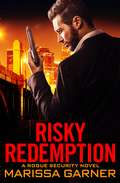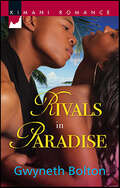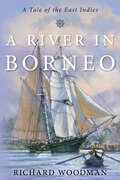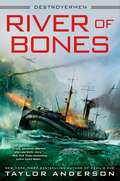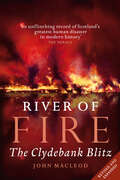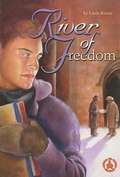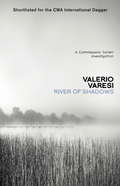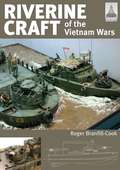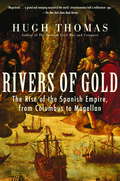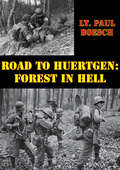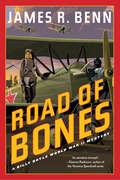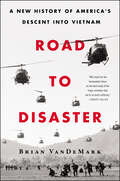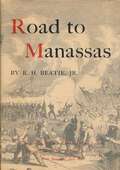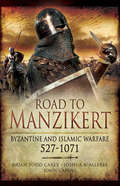- Table View
- List View
Risky Redemption (Rogue Security #1)
by Marissa GarnerFour years ago, Angela Reardon was brutally attacked, and she still bears the physical scars and traumatic memories. While she's worked hard to overcome her fears and build a successful business, she's still haunted by her inability to identify her assailant. Now Angela only wants to be left alone-until a shadowy stranger reignites her desire to be loved. But their time together may be brief...because someone wants her dead.CIA assassin Jake Stone's targets deserved to die. Until now. Until he falls in love with the innocent woman he's been hired to kill. Jake can't fight his attraction to Angela, and he knows that someone else will be sent to finish the job. So can he save Angela and redeem himself by uncovering who wants her killed? When the trail leads him into the carnal underbelly of L.A., the truth is more shocking than even he could ever imagine.
Ritchie Boy Secrets: How a Force of Immigrants and Refugees Helped Win World War II
by Beverley Driver EddyIn June 1942, the U.S. Army began recruiting immigrants, the children of immigrants, refugees, and others with language skills and knowledge of enemy lands and cultures for a special military intelligence group being trained in the mountains of northern Maryland and sent into Europe and the Pacific. Ultimately, 15,000 men and some women received this specialized training and went on to make vital contributions to victory in World War II. This is their story, which Beverley Driver Eddy tells thoroughly and colorfully, drawing heavily on interviews with surviving Ritchie Boys.The army recruited not just those fluent in German, French, Italian, and Polish (approximately a fifth were Jewish refugees from Europe), but also Arabic, Japanese, Dutch, Greek, Norwegian, Russian, Turkish, and other languages—as well as some 200 Native Americans and 200 WACs. They were trained in photo interpretation, terrain analysis, POW interrogation, counterintelligence, espionage, signal intelligence (including pigeons), mapmaking, intelligence gathering, and close combat.Many landed in France on D-Day. Many more fanned out across Europe and around the world completing their missions, often in cooperation with the OSS and Counterintelligence Corps, sometimes on the front lines, often behind the lines. The Ritchie Boys&’ intelligence proved vital during the liberation of Paris and the Battle of the Bulge. They helped craft the print and radio propaganda that wore down German homefront morale. If caught, they could have been executed as spies. After the war they translated and interrogated at the Nuremberg trials. One participated in using war criminal Klaus Barbie as an anti-communist agent. Meanwhile, Ritchie Boys in the Pacific Theater of Operations collected intelligence in Burma and China, directed bombing raids in New Guinea and the Philippines, and fought on Okinawa and Iwo Jima.This is a different kind of World War II story, and Eddy tells it with conviction, supported by years of research and interviews.
Rites of Retaliation: Civilization, Soldiers, and Campaigns in the American Civil War (The Steven and Janice Brose Lectures in the Civil War Era)
by Lorien FooteDuring the Civil War, Union and Confederate politicians, military commanders, everyday soldiers, and civilians claimed their approach to the conflict was civilized, in keeping with centuries of military tradition meant to restrain violence and preserve national honor. One hallmark of civilized warfare was a highly ritualized approach to retaliation. This ritual provided a forum to accuse the enemy of excessive behavior, to negotiate redress according to the laws of war, and to appeal to the judgment of other civilized nations. As the war progressed, Northerners and Southerners feared they were losing their essential identity as civilized, and the attention to retaliation grew more intense. When Black soldiers joined the Union army in campaigns in South Carolina, Georgia, and Florida, raiding plantations and liberating enslaved people, Confederates argued the war had become a servile insurrection. And when Confederates massacred Black troops after battle, killed white Union foragers after capture, and used prisoners of war as human shields, Federals thought their enemy raised the black flag and embraced savagery.Blending military and cultural history, Lorien Foote's rich and insightful book sheds light on how Americans fought over what it meant to be civilized and who should be extended the protections of a civilized world.
Rites of Spring: The Great War and the Birth of the Modern Age
by Modris EksteinsThis award-winning cultural history reveals how the Great War changed humanity. This sweeping volume probes the origins, the impact, and the aftermath of World War I—from the premiere of Igor Stravinsky&’s ballet The Rite of Spring in 1913 to the death of Hitler in 1945. &“The Great War,&” as Modris Eksteins writes, &“was the psychological turning point . . . for modernism as a whole. The urge to create and the urge to destroy had changed places.&” In this &“bold and fertile book&” (The Atlantic Monthly), Eksteins goes on to chart the seismic shifts in human consciousness brought about by this great cataclysm, through the lives and words of ordinary people, works of literature, and such events as Lindbergh&’s transatlantic flight and the publication of the first modern bestseller, All Quiet on the Western Front. Rites of Spring is a rare and remarkable work, a cultural history that redefines the way we look at our past—and toward our future.
Rivalries that Destroyed the Roman Republic
by Jeremiah McCallThis is the story of how some Roman aristocrats grew so competitive in their political rivalries that they destroyed their Republic, in the late second to mid-first century BCE. Politics had always been a fractious game at Rome as aristocratic competitors strove to outshine one another in elected offices and honors, all ostensibly in the name of serving the Republic. And for centuries it had worked - or at least worked for these elite and elitist competitors. Enemies were defeated, glory was spread round the ruling class, and the empire of the Republic steadily grew. When rivalries grew too bitter, when aristocrats seemed headed toward excessive power, the oligarchy of the Roman Senate would curb its more competitive members, fostering consensus that allowed the system—the competitive arena for offices and honors, and the domination of the Senate—to continue. But as Rome came to rule much of the Mediterranean, aristocratic competitions grew too fierce; the prizes for winning were too great. And so, a series of bitter rivalries combined with the social and political pressures of the day to disintegrate the Republic. This is the story of those bitter rivalries from the senatorial debates of Fabius and Scipio, to the censorial purges of Cato; from the murders of Tiberius and Gaius Gracchus, to the ultimate rivalry of Caesar and Pompey. A work of historical investigation, Rivalries that Destroyed the Roman Republic introduces readers not only to the story of the Republic's collapse but the often-scarce and problematic evidence from which the story of these actors and their struggles is woven.
Rivals in Paradise
by Gwyneth BoltonCicely Stevens needs the vacation of a lifetime. After being cheated on by her boyfriend and passed over for a promotion, she's off to the Caribbean for a weekend of hot island fun. And there's no sexier bad boy than her old college rival Chase Yearwood, who's on the same plane en route to his lush estate...and whose kiss Cicely never forgot. When he takes her in his arms again, he's more irresistible than ever. But will she lose her heart before this fling is flung?They call him the "Wolf" because of his legendary skills in the boardroom-and the bedroom. Now is Chase's chance to even the score with the woman who once beat him at his own game. But can rivals in business become passionate partners in love? Under a romantic tropical moon, he'll seduce her with a passion that will have her begging for more!
River Gunboats: An Illustrated Encyclopaedia
by Roger Branfill-CookA comprehensive, fully illustrated encyclopedia of river gunboats from the early 19th century to the present day. The first recorded engagement by a steam-powered warship took place on a river, when in 1824 the Honorable East India Company&’s gunboat Diana went into action on the Irrawaddy in Burma. In the 150 years that followed, river gunboats played a significant part in over forty campaigns and individual actions around the world. This comprehensive reference book covers the development of riverboat warfare from the early 19th century to current riverine combat vessels in service today. River gunboats proved to be the decisive factor in a wide range of conflicts across the world—from the New Zealand Wars to the American Civil War, and from both World Wars to the conflicts in Indochina and Vietnam. This lavishly illustrated encyclopedia describes the river gunboats that saw action, plus those converted river steamers which took part in combat. This volume also includes maps of the river systems where they operated, together with narratives of the principal actions involving river gunboats.
River Run Red
by Andrew WardOn April 12, 1864, a force of more than 3,000 Confederate cavalry under Nathan Bedford Forrest galloped across West Tennessee to storm Fort Pillow on the Mississippi River, overwhelming a garrison of some 350 Southern white Unionists and over 300 former slaves turned artillerymen. By the next day, hundreds of Federals were dead or wounded, more than 60 black troops had been captured and reenslaved, and more than 100 white troops had been marched off to their doom at Andersonville. Confederates called this bloody battle and its aftermath a hard- won victory. Northerners deemed it premeditated slaughter. To this day, Fort Pillow remains one of the most controversial battles in American history. The fullest, most accurate account of the battle yet written, River Run Redvividly depicts the incompetence and corruption of Union occupation in Tennessee, the horrors of guerrilla warfare, and the pent-up bigotry and rage that found its release at Fort Pillow. Andrew Ward brings to life the garrison's black troops and their ambivalent white comrades, and the intrepid Confederate cavalrymen who rode with the slave trading Nathan Bedford Forrest, future founder of the Ku Klux Klan. The result is a fast-paced narrative that hurtles toward that fateful April day and beyond to establish Fort Pillow's true significance in the annals of American history. Destined to become as controversial as the battle itself, River Run Redis sure to appeal to readers of James McPherson's bestselling Crossroads of Freedom: Antietam.
River in Borneo: A Tale of the East Indies
by Richard WoodmanIt is the summer of 1964 during the Far Eastern war euphemistically called &‘Confrontation.&’ A British Royal Marine patrol has orders to penetrate Indonesian Borneo to locate a river thought by Allied intelligence to be in use by the Indonesians to build up supplies before launching a major attack on Sarawak. Charged with this mission, Lieutenant Charles Kirton makes a most extraordinary discovery amid the dense mangrove swamps bordering a river in Borneo. What he finds not only enables Kirton to fulfil his mission, but also turns out to be intensely personal and macabre as the truth behind the strange event is revealed. From this highly charged opening sequence, the story flashes back a century to 1867, when young Henry Kirton, second officer of the auxiliary steamship River Tay, is dumped ashore in Singapore, badly injured by a fall from the rigging of his ship. Woodman&’s compelling tale has echoes of Joseph Conrad.
River of Blood
by Len LevinsonIf war is hell, these guys would hate heaven! When you want to win a battle, you get real men. When you want to win a war, you get The Rat Bastards. When they're not fighting among themselves, they're tearing raw, living chunks out of the enemy. Nothing-not death lurking in the jungle, not the wrath of a raging river-can stop the killer squad they call...The Rat Bastards.
River of Blood: Errand of Vengeance Book Three (Star Trek: Vanguard #Vol. 3)
by Kevin RyanEvery person has a story, and those who are lucky enough to share the voyages of Capt. James T. Kirk aboard the Starship Enterprise have stories unlike anyone else's. Some live, some die, but even those who serve below deck sometimes make all the difference in the universe! The news from Starfleet Command is grim: a full-scale war against the Klingon Empire is coming, a war that the Federation may not be able to win. In anticipation of a monumental conflict, the U.S.S. Enterprise is assigned to guard a vital starbase located perilously close to Klingon space. But even as Kirk's mission brings him into a tense confrontation with an invading Klingon battle cruiser, an equally deadly menace lurks within the ranks of his own crew: Klingon infiltrator agents, posing as Starfleet officers and sworn to destroy the enemies of the Empire -- even at the cost oftheir own honor!
River of Bones (Destroyermen #13)
by Taylor AndersonThe crew of a WWII destroyer face their greatest challenge yet as they try to survive in a strange new world in the next thrilling book in the New York Times bestselling series.Commander Matt Reddy and his crew are afraid it may finally be the end of the USS Walker. Ever since their ship was transported to another world, and they became embroiled in a deadly conflict between the Lemurians and the vicious Grik, the Walker has been taking a pounding. With Walker out of commission for repairs, Reddy takes command of a different ship and joins a desperate battle to block the Grik swarm.Meanwhile, the humans and their allies face a deadly second front in the Republic to the south. All of Reddy's forces are committed, and there's no turning back. Either they'll win--or lose--everything . . .
River of Death--The Chickamauga Campaign: Volume 1: The Fall of Chattanooga (Civil War America)
by William Glenn RobertsonThe Battle of Chickamauga was the third bloodiest of the American Civil War and the only major Confederate victory in the conflict's western theater. It pitted Braxton Bragg's Army of Tennessee against William S. Rosecrans's Army of the Cumberland and resulted in more than 34,500 casualties. In this first volume of an authoritative two-volume history of the Chickamauga Campaign, William Glenn Robertson provides a richly detailed narrative of military operations in southeastern and eastern Tennessee as two armies prepared to meet along the "River of Death." Robertson tracks the two opposing armies from July 1863 through Bragg's strategic decision to abandon Chattanooga on September 9. Drawing on all relevant primary and secondary sources, Robertson devotes special attention to the personalities and thinking of the opposing generals and their staffs. He also sheds new light on the role of railroads on operations in these landlocked battlegrounds, as well as the intelligence gathered and used by both sides.Delving deep into the strategic machinations, maneuvers, and smaller clashes that led to the bloody events of September 19@–20, 1863, Robertson reveals that the road to Chickamauga was as consequential as the unfolding of the battle itself.
River of Fire: The Clydebank Blitz
by John Macleod&“An unflinching record of Scotland&’s greatest human disaster in modern history&”—the Luftwaffe air raids on the industrial town of Clydebank during WWII (The Herald). Vibrating with endeavors for Britain&’s effort against the might of Nazi Germany, Clydebank was—in hindsight—an obvious target for the attentions of the Luftwaffe. When, on the evening of 13 March 1941, the authorities first detected that Clydebank was &“on beam&”—targeted by the primitive radio-guidance system of the German bombers—no effort was made to raise the alarm or to direct the residents to shelter or flight. Within the hour, a vast timber-yard, three oil-stores, and two distilleries were ablaze, one pouring flaming whisky into a burn that ran blazing into the Clyde itself in vivid ribbons of fire. And still the Germans came; and Clydebank, now an inferno, lay illuminated and defenseless as heavy bombs of high-explosive, as land-mines and parachute blasters began to fall. With reference to written sources and the memories of those who survived the experience, John MacLeod tells the story of the Clydebank Blitz and the terrible scale of death and devastation, speculating on why its incineration has been so widely forgotten and its ordeal denied any place in national honor.&“MacLeod is a splendid and elegiac narrator of neglected patches of Scotland&’s history and brings his poetic gifts again to this, the single most dreadful event in our nation&’s story.&” —The Guardian&“Invigorating—The vast amount of research involved shines through every page.&” —The West Highland Free Press
River of Freedom
by Linda BaxterSasha is enjoying his new freedom in America, but he is still haunted by the events of World War II. Ages 9-12.
River of Perfumes: A Novel of Marine Combat Correspondents in Hue City during Vietnam's Tet Offensive
by Michael StokeyIn post–World War II America, boys dreamed of adventure, listened to Elvis Presley, and read Jack Kerouac—but as they grew up, it wasn’t cruising Route 66 in a Corvette that united them, but Highway 1, known as the “Street Without Joy,” just outside Hue city in Vietnam. The US was immersed in the Age of Aquarius, the civil rights movement, the pill, and young girls in long boots and short skirts—but life was completely different for those in the jungle and rice paddies of Southeast Asia during the 1968 Tet Offensive. Full of innocence and dreams, adolescent passion and coming of age horror, River of Perfumes captures the contradictions of the times. It examines what the brutality of war does to young men in battle, and what happens to a country that abandons them.
River of Shadows: A Commissario Soneri Mystery
by Valerio VaresiIntroducing Commissario Soneri - Italy's answer to Inspector Maigret - and shortlisted for the C.W.A. International Dagger, River of Shadows is a brooding, visceral crime novel packed with atmosphere and tension."A master storyteller" Barry Forshaw, IndependentA relentless deluge lashes the Po Valley, and the river itself swells beyond its limits. A barge breaks free of its moorings and drifts erratically downstream; when finally it runs aground its seasoned pilot is nowhere to be found. The following day, an elderly man of the same surname falls from the window of a nearby hospital. Commissario Soneri, scornful of his superiors' scepticism, is convinced the two incidents are linked. Stonewalled by the bargemen who make their living along the riverbank, he scours the floodplain for clues. As the waters begin to ebb, the river yields up its secrets: tales of past brutality, bitter rivalry and revenge.
River of Shadows: A Commissario Soneri Mystery
by Valerio VaresiIntroducing Commissario Soneri - Italy's answer to Inspector Maigret - and shortlisted for the C.W.A. International Dagger, River of Shadows is a brooding, visceral crime novel packed with atmosphere and tension."A master storyteller" Barry Forshaw, IndependentA relentless deluge lashes the Po Valley, and the river itself swells beyond its limits. A barge breaks free of its moorings and drifts erratically downstream; when finally it runs aground its seasoned pilot is nowhere to be found. The following day, an elderly man of the same surname falls from the window of a nearby hospital. Commissario Soneri, scornful of his superiors' scepticism, is convinced the two incidents are linked. Stonewalled by the bargemen who make their living along the riverbank, he scours the floodplain for clues. As the waters begin to ebb, the river yields up its secrets: tales of past brutality, bitter rivalry and revenge.
Riverine Craft of the Vietnam Wars (ShipCraft #26)
by Roger Branfill-Cook“Provides clear and succinct descriptions of the various craft used not only by American forces but those of the French and South Vietnamese Navy.” —Army Rumour Service (ARRSE)The ShipCraft series provides in-depth information about building and modifying model kits of famous warship types. Lavishly illustrated, each book takes the modeler through a brief history of the subject, highlighting differences between ships and changes in their appearance over their careers. This includes paint schemes and camouflage, featuring color profiles and highly detailed line drawings and scale plans. The modeling section reviews the strengths and weaknesses of available kits, lists commercial accessory sets for super-detailing of the subjects, and provides hints on modifying and improving the basic kit. This is followed by an extensive photographic gallery of selected high-quality models in a variety of scales, and the book concludes with a section on research references—books, monographs, large-scale plans and relevant websites. This volume is something of a departure for the series in covering a wide variety of the types, at first improvised and then purpose-built for the Brown Water conflict. Besides the well-known American involvement, the book also covers some of the craft used by the French in their earlier struggle with Vietnamese guerrillas. With its unparalleled level of visual information—paint schemes, models, line drawings and photographs—this book is simply the best reference for any modelmaker setting out to build one of these unusual craft.“Very well written . . . The author’s interest, knowledge and enthusiasm come through the content and make the title so appealing to the reader.” —Armorama
Rivers of Gold
by Hugh ThomasFrom one of the greatest historians of the Spanish world, here is a fresh and fascinating account of Spain's early conquests in the Americas. Hugh Thomas's magisterial narrative of Spain in the New World has all the characteristics of great historical literature: amazing discoveries, ambition, greed, religious fanaticism, court intrigue, and a battle for the soul of humankind.Hugh Thomas shows Spain at the dawn of the sixteenth century as a world power on the brink of greatness. Her monarchs, Fernando and Isabel, had retaken Granada from Islam, thereby completing restoration of the entire Iberian peninsula to Catholic rule. Flush with success, they agreed to sponsor an obscure Genoese sailor's plan to sail west to the Indies, where, legend purported, gold and spices flowed as if they were rivers. For Spain and for the world, this decision to send Christopher Columbus west was epochal--the dividing line between the medieval and the modern.Spain's colonial adventures began inauspiciously: Columbus's meagerly funded expedition cost less than a Spanish princess's recent wedding. In spite of its small scale, it was a mission of astounding scope: to claim for Spain all the wealth of the Indies. The gold alone, thought Columbus, would fund a grand Crusade to reunite Christendom with its holy city, Jerusalem. The lofty aspirations of the first explorers died hard, as the pursuit of wealth and glory competed with the pursuit of pious impulses. The adventurers from Spain were also, of course, curious about geographical mysteries, and they had a remarkable loyalty to their country. But rather than bridging earth and heaven, Spain's many conquests bore a bitter fruit. In their search for gold, Spaniards enslaved "Indians" from the Bahamas and the South American mainland. The eloquent protests of Bartolomé de las Casas, here much discussed, began almost immediately. Columbus and other Spanish explorers--Cortés, Ponce de León, and Magellan among them--created an empire for Spain of unsurpassed size and scope. But the door was soon open for other powers, enemies of Spain, to stake their claims.Great men and women dominate these pages: cardinals and bishops, priors and sailors, landowners and warriors, princes and priests, noblemen and their determined wives.Rivers of Gold is a great story brilliantly told. More significant, it is an engrossing history with many profound--often disturbing--echoes in the present.
Road To Huertgen: Forest In Hell [Illustrated Edition]
by Lt. Paul BoeschIncludes 100 illus.Speak of the Huertgen Forest and you speak of hell.During a seemingly interminable three months, from mid-Sep. to mid-Dec. 1944, six American infantry divisions-the 1st, 4th, 8th, 9th, 28th, and 83d-and part of the 5th Armored fought at one time or another in the Huertgen Forest. These divisions incurred 28,000 casualties, including 8,000 due to combat exhaustion and rain, mud, sleet, and cold. One division lost more than 6,000, a figure exceeded for a single World War II engagement-if indeed it was exceeded-only by the bloody Marine battle on Tarawa.The name Huertgen Forest is one the American soldier applied to some 1,300 square miles of densely-wooded, roller-coaster real estate along the German-Belgian border south and southeast of Aachen....The forest lay athwart the path which the First U.S. Army had to take to reach the Rhine River, and thus American commanders considered it essential to conquer it. By the time both American and German artillery had done with it, the setting would look like a battlefield designed by the Archfiend himself.The Huertgen was the Argonne of World War II.One day not long ago another personal manuscript, much of it about the Huertgen fighting, crossed my desk. This one, I soon discovered, was different.This was a lengthy narrative written by a former lieutenant, Paul Boesch. It was obviously too long for publication, yet the combat sections of it revealed a genuine, first-hand grasp of what war is like at the shooting level and what it does to the men involved. It was too human a document to be ignored. It too faithfully mirrored the experiences, not of one man alone, but of millions, to go unnoticed. It too sharply underscored the innate faith, humor, devotion, and even the weaknesses of the American soldier to be forgotten.With Paul Boesch's permission I went to work with him to prepare this combat portion of his manuscript for publication. The result is The Road to Huertgen.
Road of Bones (A Billy Boyle WWII Mystery #16)
by James R. BennBilly Boyle is sent to the heart of the USSR to solve a double-murder at a critical turning point in the war in this latest installment of critically acclaimed James R. Benn's WWII mystery series.It&’s September 1944, and the US is poised to launch Operation Frantic, a shuttle-bombing mission to be conducted by American aircraft based in Great Britain, southern Italy, and three Soviet airfields in the Ukraine. Tensions are already high between the American and Russian allies when two intelligence agents—one Soviet, one American—are found dead at Poltava, one of the Ukrainian bases. Billy is brought in to investigate, and this time he's paired, at the insistence of the Soviets, with a KGB agent who has his own political and personal agenda. In the course of an investigation that quickly spirals out of control, Billy is aided by the Night Witches, a daring regiment of young Soviet women flying at night at very low altitudes, bombing hundreds of German installations. It&’s a turning point in the war, and allied efforts hang by a thread. Unless Billy and his KGB partner can solve the murders in an atmosphere of mutual distrust, Operation Frantic is doomed.
Road to Disaster: A New History of America's Descent into Vietnam
by Brian VanDeMark“This book is sure to appeal to those still searching for Vietnam War answers that even McNamara, Johnson, and their best and brightest advisers never found.” —Publishers Weekly (starred review)Many books have been written on the tragic decisions regarding Vietnam made by the young stars of the Kennedy and Johnson administrations. Yet despite millions of words of analysis and reflection, no historian has been able to explain why such decent, brilliant, and previously successful men stumbled so badly.That changes with Road to Disaster. Historian Brian VanDeMark draws upon decades of archival research, his own interviews with many of those involved, and a wealth of previously unheard recordings by Robert McNamara and Clark Clifford, who served as Defense Secretaries for Kennedy and Johnson. Yet beyond that, Road to Disaster is also the first history of the war to look at the cataclysmic decisions of those in the Kennedy and Johnson administrations through the prism of recent research in cognitive science, psychology, and organizational theory to explain why the “Best and the Brightest” became trapped in situations that suffocated creative thinking and willingness to dissent, why they found change so hard, and why they were so blind to their own errors.An epic history of America’s march to quagmire, Road to Disaster is a landmark in scholarship and a book of immense importance.“The most thoughtful and judicious one-volume history of the war and the American political leaders who presided over the difficult and painful decisions that shaped this history. The book will stand for the foreseeable future as the best study of the tragic mistakes that led to so much suffering.” —Robert Dallek, #1 New York Times-bestselling author
Road to Manassas: The Growth of Union Command in the Eastern Theatre from Fall of Fort Sumter to First Battle of Bull Run
by R. H. BeatieThis book focuses on the Union Army from April 14 - July 21, 1861. The book traces command and recruiting problems, carefully studies the first Bull Run, and then analyzes the battle and relates its results to the actions of Union leaders.“LACK OF PREPAREDNESS for war was a United States tradition in the nineteenth century. Without the military background of the formidable continental powers, this nation stubbornly refused to maintain a large, efficient armed force during peacetime. When conflict occurred, the government paid a stiff price for this attitude and was forced to create a military machine almost from the ground up.The author tells in detail of the period between the fall of Fort Sumter and the First Battle of Bull Run. The book falls into three divisions: the first, describing command and recruiting problems, along with personality sketches, at the war’s beginning; the second, setting down a careful study of the first Bull Run, seen through Northern eyes; the third, analyzing the battle and relating its result to the potentialities and actions of Union leaders.Strategy and tactics during these first, crucial days are carefully treated. Winfield Scott’s plans, Robert Patterson’s misadventure in the Shenandoah Valley, and the ultimate rout of Irvin McDowell’s forces make up the bulk of the book. Samuel Heintzelman, David Hunter, Daniel Tyler, Dixon Miles, Erasmus Keyes, Ambrose Burnside, Israel Richardson and other major leaders have their day in court.”-Introduction.
Road to Manzikert: Byzantine and Islamic Warfare, 527–1071
by John Cairns Brian Todd Carey Joshua B. Allfree"In August 1071, the Byzantine Emperor Romanus IV Diogenese led out a powerful army in an attempt to roll back Seljuk Turkish incursions into the Anatolian heartland of the Empire. Outmaneuvered by the Turkish sultan, Alp Arslan, Romanus was forced to give battle with only half his troops near Manzikert. By the end of that fateful day much of the Byzantine army was dead, the rest scattered in flight and the Emperor himself a captive. As a result, the Anatolian heart was torn out of the empire and it was critically weakened, while Turkish power expanded rapidly, eventually leading to Byzantine appeals for help from Western Europe, prompting the First Crusade. This book sets the battle in the context of the military history of the Byzantine Empire and the Islamic World (Arab and Seljuk Turkish) up to the pivotal engagement at Manzikert in 1071, with special emphasis on the origins, course and outcome of this battle. The composition, weapons and tactics of the very different opposing armies are analyzed. The final chapter is dedicated to assessing the impact of Manzikert on the Byzantine Empire's strategic position in Anatolia and to the battle's role as a causus belli for the Crusades. Dozens of maps and battle diagrams support the clear text. "
